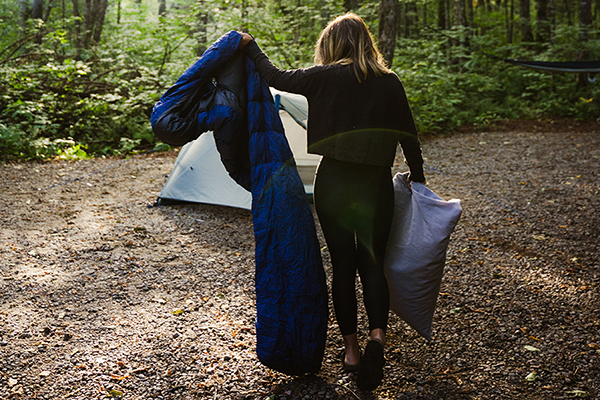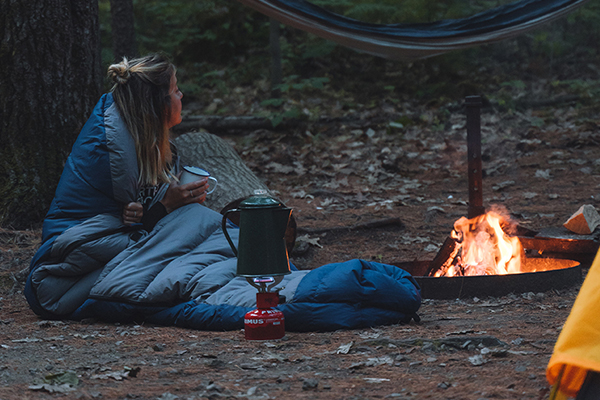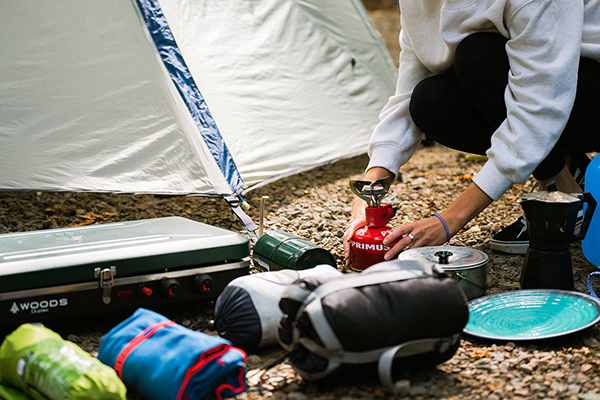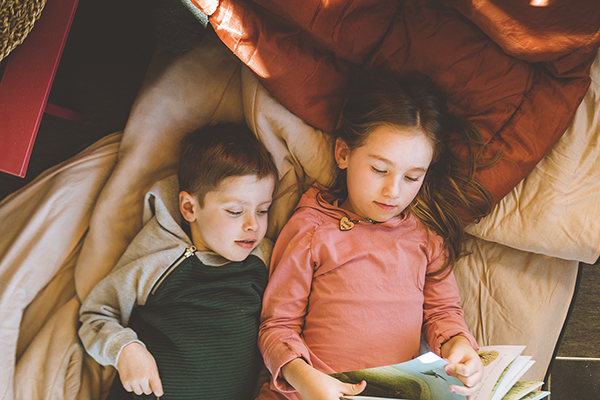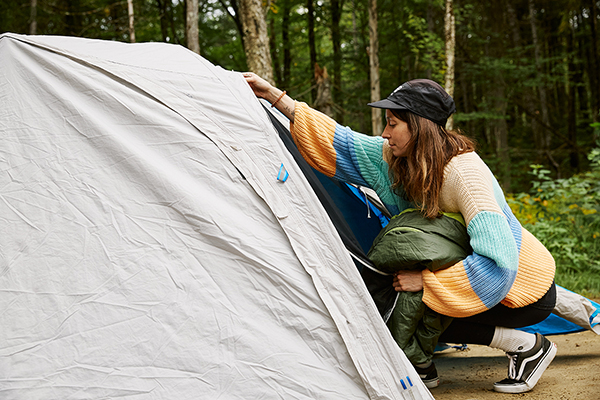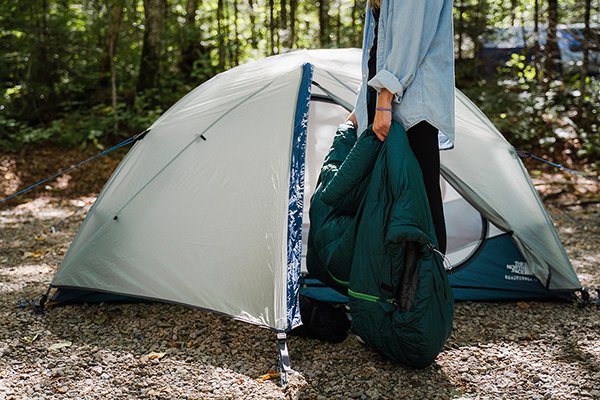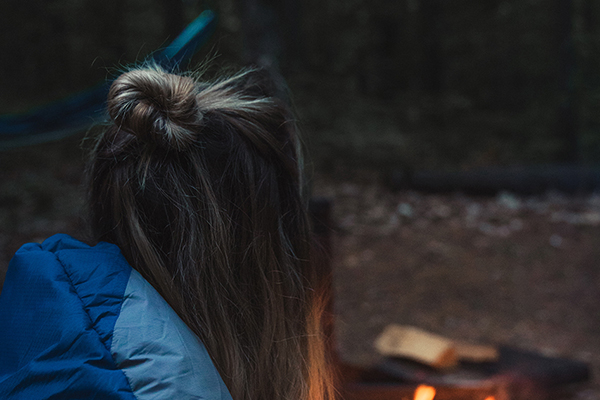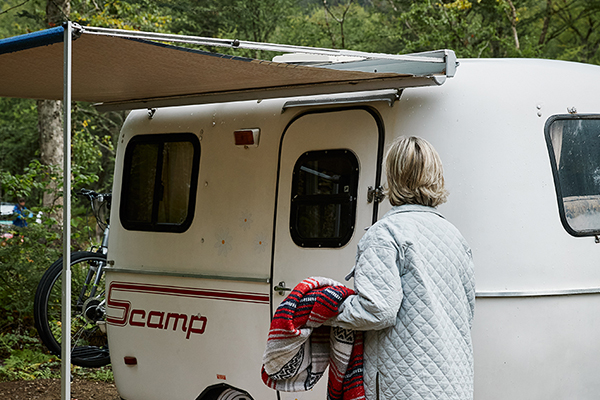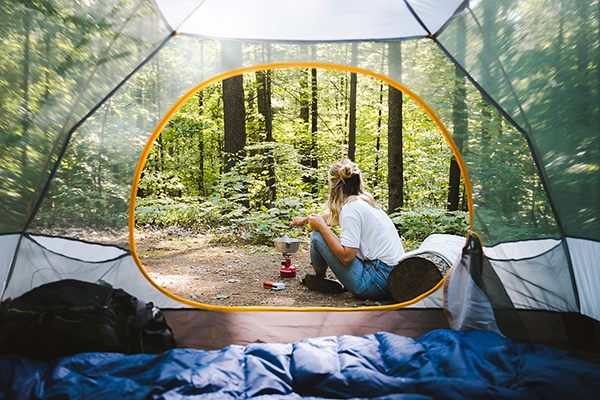Buying a sleeping bag
In collaboration with Protégez-Vous
A sound and peaceful sleep is priceless, especially when camping! To rest easy all night long, a comfortable and sufficiently warm sleeping bag is just the ticket. Follow the tips below to learn what makes for an ideal a sleeping bag.
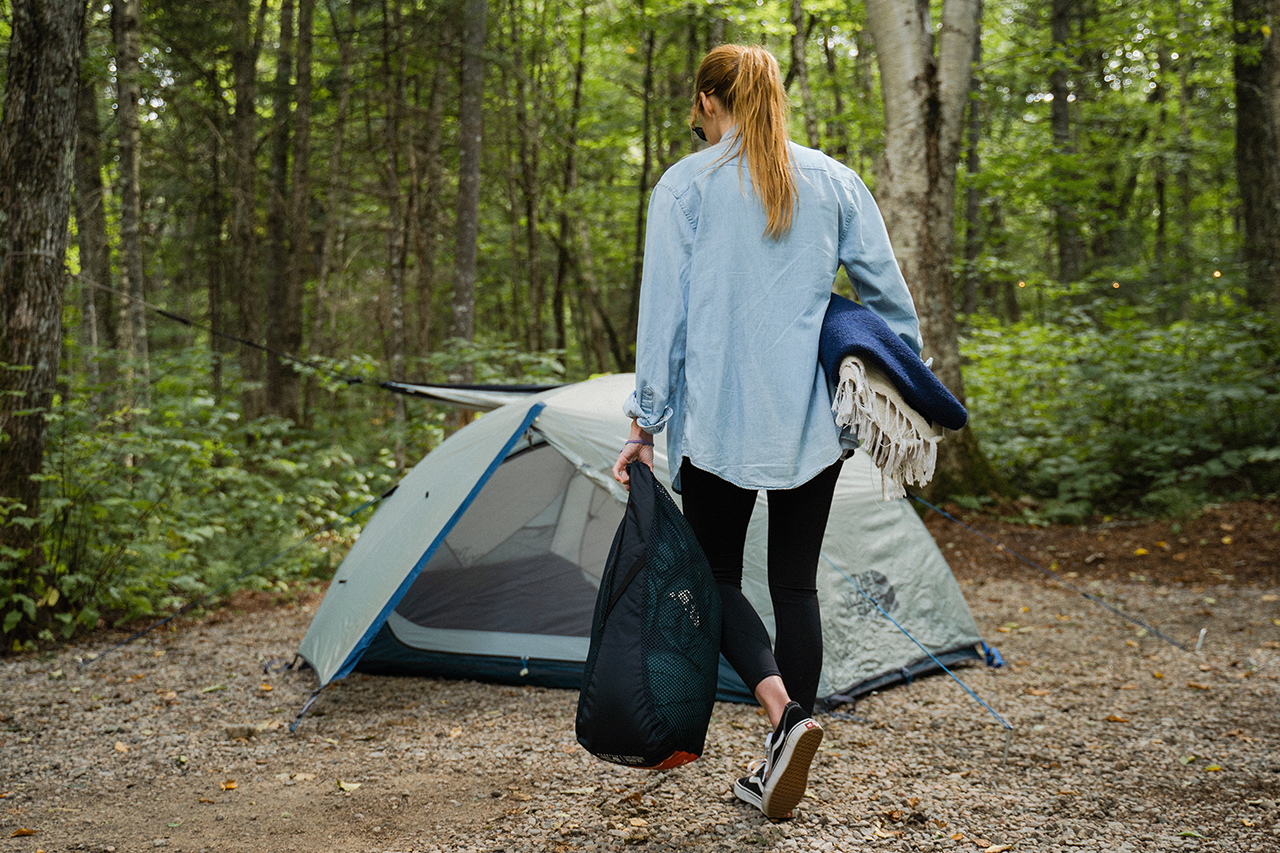 Parc national de la Jacques-Cartier
Parc national de la Jacques-Cartier
A sleeping bag is on the list of essential camping equipment, just like a tent. It protects you from the elements, such as rain and wind, and their effects (dampness and chill), which can insidiously invade your tent.
Having gone through some major changes in the last 50 years, sleeping bags range in price from tens of dollars to several hundred bucks, even if they have the same temperature rating. But not all offer an equivalent level of comfort.
A family that does some traditional camping on a fixed site for a few days per summer doesn’t need to pay an arm and a leg to stay warm. However, this is definitely not the case for a couple who, for example, wants to try wilderness camping or who pitches their tent in May as well as in October. These folks should invest in higher-end products to avoid the risk of getting cold.
The temperature rating: how to make sense of it?
Most sleeping bag manufacturers have the temperature ratings of their products certified. They obtain an ISO 23537 certification, very similar to the old EN 13537 standard, which you can still find on some products.
Two thermal capacities should normally be indicated on sleeping bags:
- The comfort temperature: This corresponds to the temperature at which you feel neither hot nor cold. Above this temperature threshold, you’ll have to open the zipper to avoid suffering from the heat. Below it, you’ll have to curl up to stay snug.
- The limit temperature: This is the temperature at which thermal equilibrium is lost. The sleeping bag can no longer retain the heat produced by your body. To overcome this discomfort, you’ll have to add layers, for example by putting on extra clothes.
Look for products with comfort and limit temperatures that cover the range of outdoor temperatures you’re likely to sleep in. For example, the Decathlon – Quechua Arpenaz 20° has a comfort temperature of 20°C and a limit temperature of 15°C.
Temperature ratings are not, however, an exact science. Many factors influence sleeping comfort, such as individual tolerance for cold. The temperatures quoted by manufacturers are nevertheless useful to compare products. In stores, you’ll find products that aren’t certified or that indicate only one temperature, without being able to know if what’s indicated corresponds to the comfort or limit temperature. This is the case for the Sail Horizon Eco 0°C. So it’s better to take the claim with a grain of salt and get a good floor mat. This insulating layer between your body and the ground is essential.
There are several types of mattresses: inflatable, self-inflating, or foam. An R-value is attributed to some of them, representing the thermal resistance of their materials. On a scale of 1 to 10, the R-value indicates whether the model is suitable for summer nights (1-2); spring and fall nights (3-4); or winter nights (4-5 and higher).
If comfort is your primary concern or if you have a physical condition that requires a very comfortable mattress, choose one with a thickness of 10 cm or more. If you don’t care how much space the mattress takes up in your luggage, opt for a self-inflating mattress that will offer you more support.
Format
In a store, you’ll find three main types of sleeping bag formats, each with its strengths and weaknesses.
Rectangular format
These sleeping bags, such as the Outbound Lite, are spacious. Since the volume of air to be heated inside the bag is greater than for other models, they’re better for summer, i.e., when the nights are warmer. For cooler nights, or if you’re easily chilled, bring along a pyjama suit. These sleeping bags are also quite bulky, which is less practical for wilderness camping.
Mummy format
Sleeping bags of this type, such as the Marmot Trestles Elite Eco 20, are form-fitted to ensure optimal heat retention. What’s more, they’re lightweight, compact, and often designed for three-season use. On the other hand, since these models are narrow and often have a hood, they may not be suitable for the way you usually sleep, especially if you’re a fan of the starfish position.
Barrel format
Barrel-shaped sleeping bags, such as the Marmot Rainbow Yolla Bolly -1°C, are an in-between breed: they’re semi-adjusted and a little bulkier than the mummies. They’re a good choice for traditional camping or even for short wilderness escapades.
Certain models are available in a single size while others come in short, regular, and long formats. Regular sizes are suitable for people under 6' (1.83 m).
Some sleeping bag models are also sold in compression sacks so you can use straps to let out air and make them as compact as possible. You can also buy a compression sack alone, which is useful for your sleeping bag or your spare clothes.
Types of insulation
Down
A down-lined sleeping bag is composed mainly (more than 90%) of short, soft, curly feathers that grow first on the body of geese or ducks. This makes the bag light, compressible, and high performing when the weather is cool, like a comforter. You can assess the density of the insulation thanks to a fill power index that starts at around 500. An index of 800, like that of the MEC Talon Light +5°C model, is a sign of good insulation.
Be that as it may, a down-filled sleeping bag tends to retain heat less well when wet. The water-repellent treatment administered by manufacturers partly prevents this phenomenon, but down-filled bags still need a lot of maintenance to retain their hydrophobic characteristics.
This type of sleeping bag is more expensive than its counterparts made of synthetic materials. Plan to pay at least $100.
Synthetic
Sleeping bags that contain synthetic insulation, such as polyester or nylon, are more affordable. You'll find them for less than $50. Even if they get wet, you’ll stay warm. A notable drawback, however, is that they’re heavy and bulky and retain heat less well when it’s cold outside.
Supplemental lining
Draft tube, floor mat straps, and/or an integrated pillowcase… these are among the possible features of a sleeping bag! Although such extras will add to your comfort, they’re not essential. In fact, your comfort level will depend on how you use them. When summer camping, you can, for example, substitute a simple toque for a sleeping bag hood for those cooler nights.
The only exception is supplemental lining, which you can purchase separately for a few extra ten-spots. Contrary to popular belief, this silk, cotton, or synthetic fiber sheet is used less to generate heat than to keep the inside of the sleeping bag clean. You’ll have to wash the sleeping bag less often, which will extend its life. Plus, you can use the sheet alone in hot weather.
Models for kids
Does your child need a made-to-measure sleeping bag? Ideally, yes. A small sleeping bag will better retain body heat, which could be unnecessarily lost in an over-sized model.
While there are sleeping bags on the market designed for smaller fry (generally 115 cm or less),you don’t really need to buy one. In fact, you can get drawstrings that can reduce the size of an adult sleeping bag so as to adapt it to your kid. You can also put a pillow at the bottom of the sleeping bag so junior doesn’t sink into its depths during the night.
If you’re still thinking of getting a children's model, you can easily find one on the market. A number of major brands such as Marmot, Mountain Hardwear, North Face, and Chinook offer rectangular or mummy models.
Responsible purchasing
You’d like to have a sleeping bag made of down, but you hesitate because it comes from an animal? There are recognized certifications to guarantee that a product has been obtained responsibly, i.e., respecting the Responsible Down Standard (RDS). The feathers and down used in Mount Trail brand sleeping bags, for example, are certified RDS.
However, synthetic fibers aren’t lily white either since their manufacture requires fossil resources such as oil. Even in this case, certain producers, among others Mount Trail and North Face, are turning to recycled materials such as polyester made from plastic bottles, which are certified Global Recycler Standard (GRS).
It's generally easy to spot these certifications on products sold in stores or online.
Borrowing or buying used?
If you plan to use a sleeping bag only a few times this summer, borrowing from friends or family is a good idea. If you're shopping for a used product, there are a few things you should check not only to make sure the sleeping bag is in good condition but also to prevent an infestation of fleas, bedbugs, or other parasites at home.
Ask the salesperson questions
Ask questions about the condition of the sleeping bag, date of purchase, and storage conditions. A sleeping bag that hasn’t been stored properly may show signs of mold. For example, don’t buy a product with a strong smell.
Inspect before you buy
Do a visual inspection. Make sure the fabric isn’t stained or torn, that the zipper opens and closes completely and easily, and that the seams are still strong. Verify that it’s bed bug free. These critters are of course visible to the naked eye, but you might also detect signs of their presence: black spots, blood spots, and dead skin. If you spot evidence of parasites, don’t buy the sleeping bag.
Administer a preventive treatment
Even if you don’t see any bugs on or inside the sleeping bag, you should still transport it in a sealed plastic bag and, when you get home, put it directly in the dryer on the longest and hottest cycle possible (usually more than 30 minutes at 50°C). The uniform temperature is guaranteed to eradicate adult parasites and their eggs. Then wash the sleeping bag normally.
Your new purchase is made of down? Putting it in the dryer on the hottest cycle involves some risk since this material is delicate. You can instead use the cold treatment eradication method. Put your sleeping bag in the freezer (without compressing it) for at least four days. The temperature must be at least -18°C so that cooling is quick, thus preventing bedbugs from adapting and surviving.
Sleeping well when it’s chilly
Not being cold at night can make a significant difference in terms of the quality of your sleep and the pleasure of camping. Here are some tips to help you sleep like a log.
Stay dry
Water, humidity, and sweat will make you cold. This is why you have to stay dry, along with your equipment (sleeping bag) and your bedclothes. (If these have gotten wet from the rain, dry them out before wearing them again.) Use a sleeping bag instead of simple blankets, as covers absorb moisture and are difficult to dry. And last but not least, don’t wear clothes that you’ve sweated in.
Dress appropriately
If you’re worried about catching a cold, wear warm long underwear made of synthetic fabric or merino wool. Unlike cotton, for example, these fabrics are breathable and don’t trap moisture.
Cover your extremities
To preserve your body heat really well, cover your feet and head. Don’t hesitate to wear a toque and socks (other than cotton) to sleep.
Get a camping blanket
This type of blanket can be made of a nylon outer fabric with polar fleece or polyester lining or even synthetic insulation that keeps you warm. Contrary to an ordinary cotton blanket, for example, camping blankets dry quickly, don’t absorb moisture, and have often been treated with a water repellent that wards off rain and splashes.
Sleeping bag maintenance
- Clean the surfaces of your sleeping bag with a wet cloth. Don’t wash the whole bag unless you really have to. One deep wash per year will do the trick, especially for down-filled bags.
- Clean the sleeping bag in a washing machine set on delicate cycle.
- Use a mild detergent, without oil or fabric softener, which is ideally designed for this type of product. You can find such detergents in sports stores. If your sleeping bag is made of down, a detergent intended for this type of material normally contains an agent that helps to puff it up.
- To dry your sleeping bag, put it in the dryer on low heat. If it’s made of down, add dryer balls (or tennis balls wrapped in a cloth like in a sock), which will help disperse the down and keep it fluffy.
- Finish drying your bag by hanging it upside down on a hanger with the lining facing out, in a dry and ventilated area, then use a fan if required.
- Make sure your sleeping bag is completely dry before putting it away, otherwise it could get moldy, especially if it’s made of down.
- Between trips or during the cold season, store your sleeping bag in a dry place, in a big bag that breathes (and not in its carrying bag or compression sack).
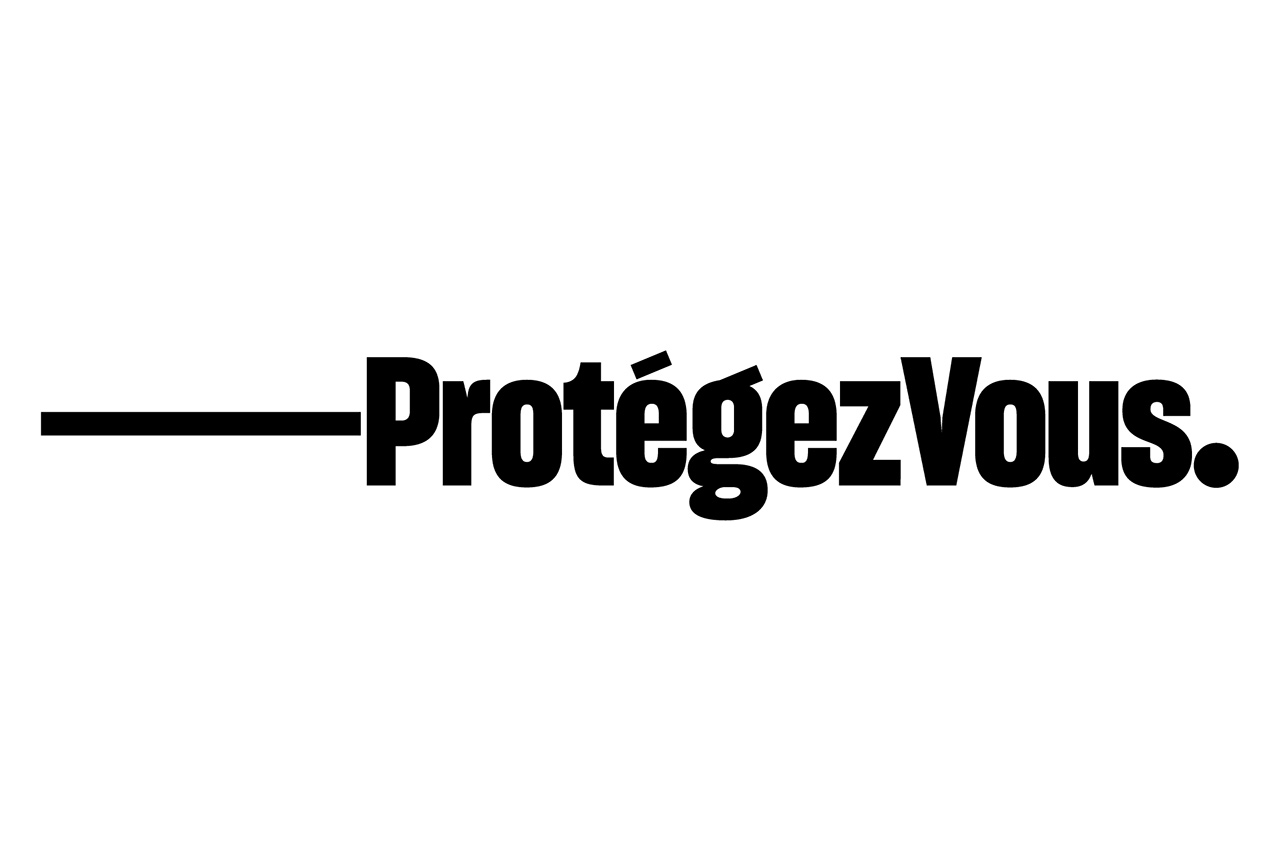
About Protégez-vous
Protégez-Vous is a non-profit, self-financed, and independent organization that informs, educates, and supports consumers in making informed and responsible choices.
